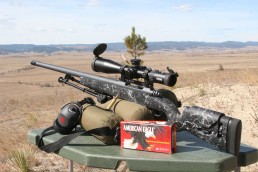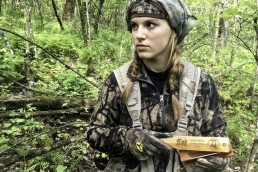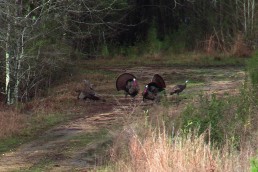Montana Rifles: Model 1999 Professional Hunter part one
SHARE THIS POST
My first contact with the Montana Firearms group took place last fall at the Champion Ranch in Brady, Texas. I was testing Norma’s new poly-tip bullets in 300 Winchester while hunting whitetails, and was using the Montana Rifle Model 1999, the NRA gun of the year for 2016. Two days with the rifle convinced me that the almost custom rebuild of the outstanding pre-1964 Winchester had taken place.
With an action and barrel built around some very outstanding walnut and set of controls exactly like those of my tried and true Winchester Model 70 Feather Weight in .30-06 that’s killed many deer, I felt I was in the driver’s seat when afield. Just two days on tower stands, and two fine bucks were dropped cleanly inside 200 yards with one well-placed shot for each. A previous field-range day had yielded two shots touching at 100 yards, which ended my test phase and zeroing time in terms of hunting the Champion for trophy whitetails.
The bottom line is I was completely taken aback by the sheer quality and performance.
I also hunted the Montana light rifle back in South Dakota using a hide built on a hilltop between some rolling hills and a large cattail swamp. I locked my sights on a nice four-by-four whitetail buck, but he was at an extended range of 436 yards, judging by my Leica 2000 range finder. With a Leupold VX-1 4X12 that had an adjustable target elevation turret installed, I clicked up three MOA and sent the 300 Win Mag Norma round downrange. The deer was busy with its head in a doe track and was stationary at that extended range limit. When the big 180-grain, 30-caliber bullet hit him a bit low in the lungs, he simply walked off and dropped dead about 25 yards later. That third buck of the season had met up with the cutting-edge turn-bolt Montana rifle product. Needless to say, I was as impressed as can be about the whole deal, but I wanted to know more about this rifle builder that had set up shop up in the high country of the Big Sky State. After a short note to the folks at Montana Rifles, I was then advised—since I was right in the middle of some specialized ultra-long-range shooting—and they said they had a sample of their tactical 338 Lapua Model 1999 available for testing and were willing send the big rifle my way.
The Model 1999 Professional Hunter is a heavy, full-scale sniper rifle designed for a counter-operations sniper system and sand box fighting. With my background and three books on long-range shooting, I noted the possibilities associated with this long-range rifle. The MTR—as we will call this death-at-a-distance shooting machine—is made up of a T-3 custom-built glass stock with full cheek adjustments and length of pull adjustments built in into its furniture.
The exact LOP is 13 1/4 to 15 inches, it’s dressed in sniper gray and the rifle stock retains a heavy-target contour design. The metal work in the bottom is crafted like a fine piece of sculpture with smoother snag-free edges with a fit a watchmaker would want. The barreled action retains a 26-inch, button-hand-lapped 1-10 twist barrel. The action on the Model 1999 consists of the Montana PH model, which, for the most part, is a remake but oversized version of the Winchester Model 70, in my opinion. Making use of a Mauser-style ejector, this stainless steel receiver as a control-round feed is blueprinted for accuracy. Even loading a round into the chamber, a shooter can “feel” the final snug fit that requires an extra push into the minute, hand-lapped breech face. After test-shooting four additional 338 Lapua rifles over a year and researching for articles and a possible fifth book, I was able to note the different lock-up associated with this masterpiece of a rifle.
Are you enjoying this post?
You can be among the first to get the latest info on where to go, what to use and how to use it!
If you’re asking if I like this rifle, the answer is yes. This is an outstanding ultra-long-range shooting system.
Downrange
Taking the rifle out for the customary “zero” run to 100 yards was eye opening. So much so, that I fired a total of two rounds for a dead-on-the-target center zero. Shooting the military German Steiner optics in milrads proved to be a good choice, especially because its adjustments from the first focal plane were set at 10X and were spot-on. The MTC muzzle break reacted to my hand load consisting of a charge of RL 19 with a Sierra 250-grain MK bullet and sharp but almost gentle nudge. The 18 3/4-pound rifle has optics laying in sandbags like an oversized sporter, and illustrated this through its solid design and bench rifle or ultra-long-range target/game system. The only reason I held on to the rifle was so I could spot my exact bullet splash downrange for any target correction in the event I missed my mark. Recoil is about the same as a medium sporter in a 308 Winchester.
Shooting for the group, the hand load previously drilled a 0.671 at 100 yards. Montana Rifles says this rifle out of the box is a sub-1.2 MOA shooter based on the PH number 7 barrel and Timney Trigger. I was shooting in light winds at about 3,000 feet above sea level. This rifle is a dead-on shooting system, and with the correct loads it can push accurate bullets to distances up to a mile or more. When I did hit the real deal regarding pushing bullets over some long-range real estate, the rifle’s accuracy shined. Most of my attention was directed toward practical, long-range steel targets.
Action Targets E-50 steel at 1,000 yards. Note the center line of hits of the 338 Montana (1,000 yards). The high winds are gusting to 20 mph.
L.P. Brezny on Dead Horse Ridge with a 1,000-yard shot on steel.
MWO
SHARE THIS POST
Did you enjoy this post?
You can be among the first to get the latest info on where to go, what to use and how to use it!
L.P. Brezny
Writing on outdoor subjects for over 40 years, L.P. Brezny has written four books on shotgun and rifle (ballistics and performance). He’s an expert at smoothbore, and high-power, ultra-long-range shooting. He’s a specialist, producing reviews covering general products used in the outdoors industry.



